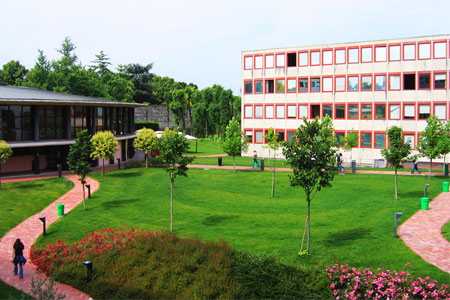Syllabus
------------------------
MM: 2E PARTIE
------------------------
The second part of the programme corresponds to the first part
------------------------
MM: 1ÈRE PARTIE
------------------------
1. Diatopic variation and French language over the world (basic notions). Québec French. 2. Types of phraseological units ("locutions", "collocations", "pragmatèmes", "clichés") and examples through comparison between phraseological units in France French and phraseological units in Québec French. 3. Application of theoretical notions to didactic context (French L2 teaching and learning). Didactic methods Attending students Lectures concerning diatopic variation with particular reference to Quebec French, theoretical notions about phraseological units, and exercises related to the different types of phraseological units. The last part of the course, with the participation of Prof. Ophélie Tremblay (Université du Québec à Montréal) will be dedicated to the application of theoretical notions to didactic context. Students may choose to present, during the course, a proposal for teaching unit focusing on phraseologial units in French L2. The course materials and any further details will be published after each lecture on the dedicated e-learning platform, which will include calendarization of the lessons and detailed program, available from the first lesson. During the academic year the teacher will be available during office hours (see web page). Non-attending students Non-attending students will find, on the dedicated e-learning platform, materials and insights on the subjects of the course, as well as the detailed program, available from the first lesson. The teacher will provide support during office hours (see web page). Bibliography Part one: E. Szlezák, “Le français dans le monde: Canada” in C. Polzin-Haumann-W. Schweickard, Manuel de linguistique française, Berlin-Boston, De Gruyter, pp. 478-504. Conseil supérieur de la langue française, Consensus quant à la nécessité de définir le français québecois standard (http://www.cslf.gouv.qc.ca/bibliotheque-virtuelle/publication-html/?tx_iggcpplus_pi4%5Bfile%5D=publications/avis116/a116.htm). Base de données lexicographiques panfrancophones (http://www.bdlp.org/). Multidictionnaire de la langue française (http://multidictionnaire.com/). Antidote (https://www.druide.com/). Part two: I. Mel’cuk, A. Clas, A. Polguère (1995), Introduction à la Lexicologie Explicative et Combinatoire, Louvain-la-Neuve, Duculot. I. Mel’cuk (1995), Phrasemes in Language and Phraseology in Linguistics, in M. Everaert, E.-J. Van Der Linden, A. Schenk, R. Schreuder (éds.), Idioms. Structural and Psychological Perspectives, Hillsdale-Hove, Lawrence Erlbaum Associates, pp. 167-232. I. Mel’cuk (2008), Phraséologie dans la langue et dans le dictionnaire, « Repères & Applications », VI, pp. 187-200. I. Mel’cuk (2013), Tout ce que nous voulions savoir sur les phrasèmes, mais… « Cahiers de lexicologie », 102, pp. 129-149. A. Polguère (2011), Perspective épistémologique sur l’approche linguistique Sens-Texte, « Mémoires de la Société de Linguistique de Paris », XX, pp. 79-114. I. Mel’cuk, A. Polguère (2008), Prédicats et quasi-prédicats sémantiques dans une perspective lexicographique, Lidil, 37 (http://lidil.revues.org/2691). Part three: Les langues modernes 1/2009 : « Enseigner et apprendre le lexique ». J. Scott, W. Nagy (2009), Developing word consciousness. Essential readings on vocabulary instruction. Newark: International Reading Association, pp. 106-117.
Assessment methods and criteria
------------------------
MM: 2E PARTIE
------------------------
The second part of the programme corresponds to the first part
------------------------
MM: 1ÈRE PARTIE
------------------------
Oral examination, entirely in French, aiming at ensuring the acquisition of theoretical notions and the ability to apply them in practical cases. The oral interview will test: - the breadth and completeness of the contents; - the ability to exemplify; - clarity. Attending students may pass two ongoing assessments. The first assessment (writtent test) will concern the first and second parts of the program and will consist of a set of 'open' questions and exercises concerning diatopic variation and phraseological units. The second assessment (oral exposition) will consist in the presentation of a didactic project concerning phraseological units. Each assessment will be evaluated in /30. The exam will be completed during the oral examination. The final mark will be given by the average of the oral examination and ongoing assessments. The oral examination concerns the entire program and can be taken after obtaining C2 level. The final mark will be obtained from the average of the language level converted to /30 based on the indications in the "Vademecum normativo per gli studenti dell'Area di Lingue e Letterature Straniere" and the oral examination and will be expressed in /30. ERASMUS students are asked to contact the teacher at the beginning of the course for explainations. The program, bibliography and exams are the same for all students, including non-attendants. Linguistic level required French C2 level is required. The verification of language level is based on the certifications issued by the CLA (Centro Linguistico d'Ateneo) or other institutions recognized by the MIUR (DALF C2, DFP DALF C2; please consult the dedicated web page: https: / /cla.univr.it/files/4-tabella_equipollenze.pdf) and is a preparatory to the oral examination. As indicated in the "Vademecum normativo per gli studenti dell'Area di Lingue e Letterature Straniere", the validity of C2 certification is six years from the date of attainment.







